There’s just no other place like Sardinia. It’s an island of spectacular unspoilt nature. Towering mountains slope toward the coast. Villages bookend cliffs sculpted by the wind, long beaches, and bays hidden by the Mediterranean scrub.
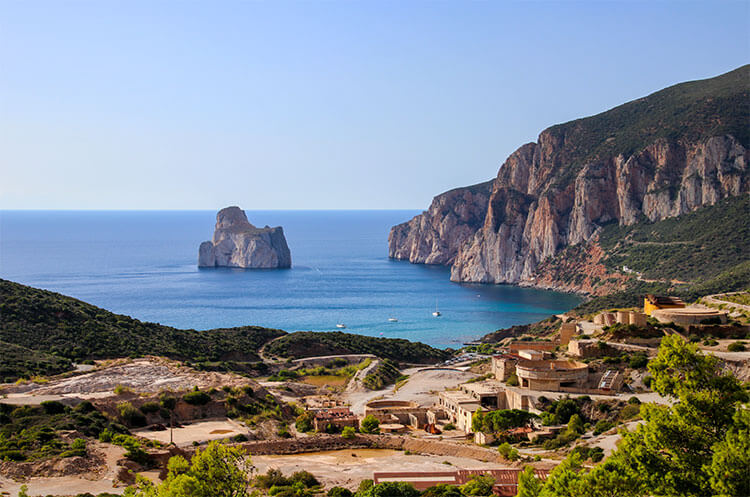
Sardinia truly does have it all. While the promise of la dolce vita and tranquil turquoise waters lapping at white sand beaches attracts visitors to Italy’s second largest island, Sardinia is so much more. With idyllic villages, ancient archaeological sites, and fascinating culture and traditions, Sardinia truly does have it all.
Sardinia is the third largest of Italy’s 20 regions by size, and the last region I had yet to explore after traveling extensively throughout the country in my seven years living there. I was thrilled to explore Sardinia and finally complete my goal of visiting every region of Italy over two weeks traveling around Sardinia’s four provinces.
What I discovered is that Sardinia has something to offer for any type of traveler. In fact, the abundance of activities and places to potentially see is almost overwhelming. But a trip through some of Sardinia’s – and, in fact some of Italy’s – most authentic and beautiful villages will leave a lasting impression.
Download the free Discover Unknown Italy eBook with the most beautiful and authentic villages from every region of Italy, including Sardinia.
How to Get to Sardinia
There’s a few ways to get to Sardinia. Most visitors, especially international visitors, arrive to one of Sardinia’s three main airports: Cagliari Elmas Airport, Olbia Airport, and Alghero Fertilia Airport. Many of the budget airlines also operate multiple daily flights from mainland Italy’s major cities like Rome and Milan for as little as €9.99 each way.
If you have more time, travel with a car by ferry from mainland Italy, France or Barcelona to reach one of Sardinia’s five ferry ports in 10-12 hours. We arrived to Sardinia at Santa Teresa Gallura via Bonifacio, Corsica in 1 hour on Ichnusa Lines and traveled back home to France directly from Porto Torres to Toulon in 10 hours on Corsica Ferries overnight.
When traveling with a dog, as we did with Coco, we can’t recommend Corsica Ferries highly enough. Dogs are welcome in all public areas of the ship, and dog-friendly cabins are available. Cabins can sleep 2 – 4 people and have a bathroom complete with shower, making sailing overnight comfortable. You basically board in the late evening and wake-up in your destination.
No matter whether you arrive to one of Sardinia’s airports or via ferry from mainland Europe, you’ll want a car to most conveniently explore Sardinia. While it is possible to get around some areas of Sardinia with public transportation, the Mediterranean island is really best visited with a car.
The Best Time to Visit Sardinia
Think of Sardinia and days of lounging on its picture-perfect beaches comes to mind for many, making Sardinia most visited from June to September. But Sardinia offers plenty of things to do beyond the beach year round.
Sardinia is at its liveliest with tours, activities and restaurants in full swing as tourists descend upon the sun-drenches beaches from June to September. These peak months also offer a calendar chock full of festivals and events. But temperatures also soar, and the most popular spots get crowded.
If you’re after more of a crowd-free holiday, consider visiting Sardinia in the shoulder season from the end of September to the end of October. Both air and sea temperatures are still warm, making Sardinia perfect for both water sports and hiking. You’ll find some things a bit more limited, like some reduced hours for restaurants and tours. But plan accordingly, and you can enjoy Sardinia practically to yourself.
Where to Go in Sardinia
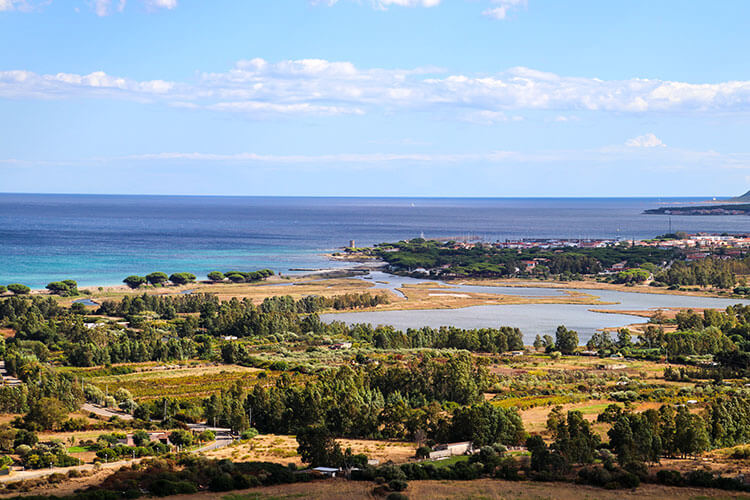
Posada
One of Italy’s most beautiful villages, Posada sits atop a hill with its colorful houses seemingly tumbling down the hillside in the north east of Sardinia. The hillside village is crowned with the now mostly ruined Castello della Fava, and offers stunning views over the Regional Natural Park of the Tepilora Oasis, a UNESCO Biosphere Reserve.
Posada is one of Sardinia’s oldest villages, which has continuously been inhabited since the Phoenicians. Once you lay eyes on the views of the nearby coast and surrounding lands, it’s clear why Posada was such a sought after village with many battles for it through its history.
Though wandering through the maze of narrow streets of the historic center is one postcard perfect Medieval scene after another, the highlight of the village is a visit to the Castello della Fava. Mostly all that remains is the tower, but the ruins and climb to the top of the tower offer breathtaking views over the Rio Posada, Regional Natural Park of the Tepilora Oasis and the unspoiled beaches of the coast.
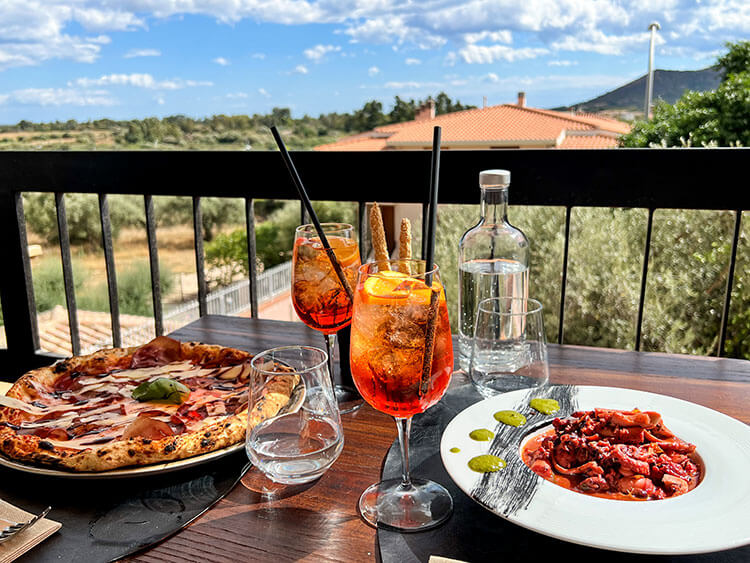
Climbing up and down the staircases and steep streets of Posada will most definitely work up an appetite. Head to Eteria Food and Drink in Posada. We had one of our best meals in Sardinia here and promise you won’t be disappointed.
Stay: B&B Feronia
Located in the heart of Posada, B&B Feronia is just a short 15 minute walk to the Castello della Fava and conveniently located to shops and restaurants in the village. It’s also just 2 kilometers from Su Tiriarzu Beach, one of the pearls of Posada and most beautiful beaches of the area.
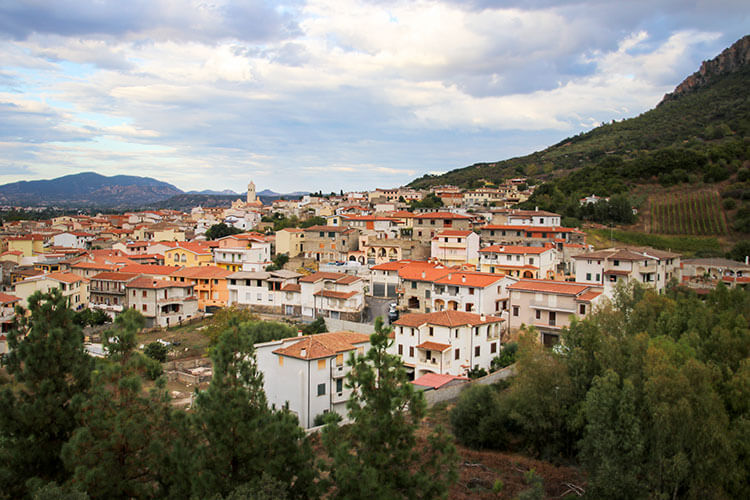
Galtellì
Located about 1 hour drive from Posada, Galtellì is one of Sardinia’s best preserved villages. Earning the distinction as one of the Borghi Autentici d’Italia (most authentic villages of Italy), Galtellì’s modern fame is linked to Italian novelist and Nobel Prize for Literature winner Grazia Deledda. With her award-winning novel Canne al Vento (Reeds in the Wind), Deledda became the first Italian woman and second woman ever to win a Nobel Prize for Literature.
The village, at the foot of panoramic Monte Tuttavista, takes great pride in Grazia Deledda choosing to set her novel in the streets of Galtellì. Pick up a map from the tourist information office in the historic heart and follow a self-guided walking tour of points of interest from Deledda’s novel interspersed with the numerous churches of Galtellì.
You also won’t want to miss the Museo Etnografico Sa Domo ‘e Sos Marras. The museum is a series of rooms with a themed collection of 18th century objects showing what life for the Galtellinese was like in that period. It’s set in a restored 18th century villa where one of Galtellì’s most prominent noble families once lived, and the curators take the time to guide visitors through the collection.
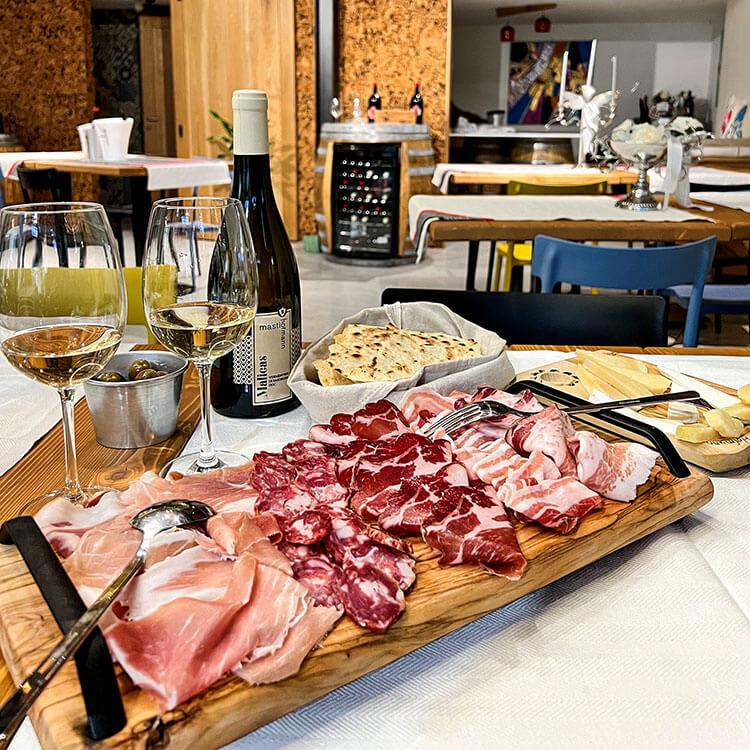
On the other end of the village, head to Cantina Mastìo Hofmann for a wine tasting with local cheese, salumi and carasau – the typical Sardinian flatbread originating from the area. The family-owned winery run by 3rd generation owner and wine maker Michele Mastìo is a chic and modern contrast to the village that otherwise feels like stepping back in time.
Stay: Castello Malicas
Stay in the historic Castello Malicas, set up on a hill and with a rooftop terrace overlooking Galtellì. The castle is just a 5-minute walk from the historic center and a few minutes walk to Cantina Mastìo Hofmann.
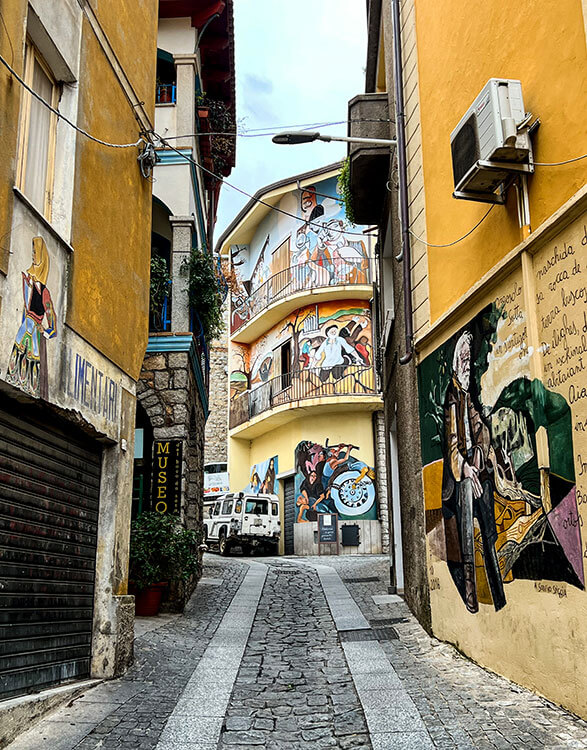
Orgosolo
Located in the vast mountainous Barbagia of central Sardinia, Orgosolo is one of Sardinia’s most unique villages. The remote and hard to access village was long known as a haven for outlaws and bandits, earning it a reputation for an anti-authoritarian attitude.
That attitude was demonstrated when in June 1969, nearly all of Orgosolo’s citizens started a non-violent protest against the Italian government. The people of Orgosolo had been given notice that the shepherds should move their flocks elsewhere so that the Italian military could create a shooting range on their common land. But the locals wouldn’t stand for their land being stolen, and after only a few days the Italian military gave up the idea and moved on from the area.
Not long after the peaceful protests, the anarchist theater group from Milan called Dioniso immortalized the revolution with a mural painting on the wall of a building right in the heart of Orgolo. Until 1975, the mural remained the only street art in Orgosolo.
Then a local teacher got the idea to teach his students about the 30th anniversary of the Partisan Struggle and Liberation from Nazi-Fascist Oppression with an art project. Initially his assignment was to create awareness for the anniversary with drawings on paper, but before too long students were painting their murals on every available surface of the villages’ buildings.
Today there are more than 150 murals, serving like a visual history lesson on the facades and rolladens of Orgosolo. You can reserve an audio guide and pick it up along with a map from a kiosk on the main square. The self-guided Orgosolo murals tour takes around 90 minutes if you listen to the short explanations about the meaning of every mural. You have the audio guide for 4 hours, which was plenty of time for us to listen to the majority of the mural explanations and take a break for lunch.
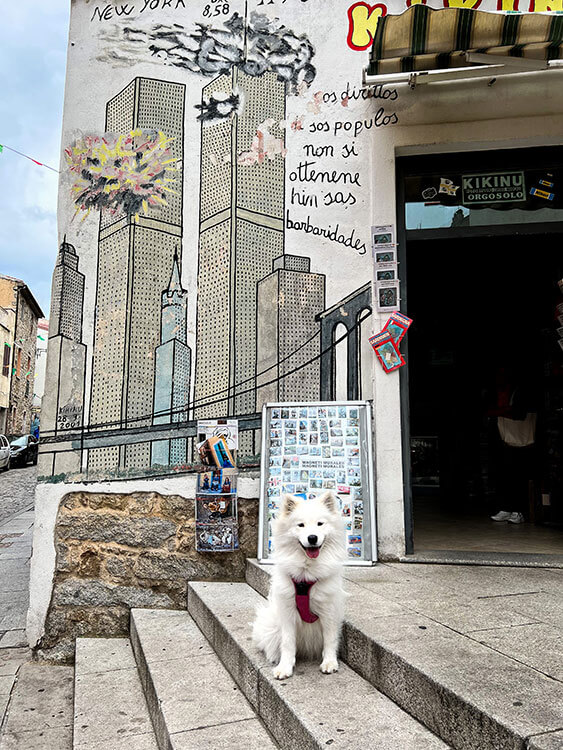
You’ll note that most of the murals have a political message. Many depict the traditional way of life of the shepherds or the citizens’ political views of the Nazi-Fascist oppression. But a number of murals depicting more recent events around the world have been added in recent years. In particular, a mural of the Twin Towers with smoke billowing out of the two gaping holes before crashing to the ground on that horrible date in September 2001 caught our attention.
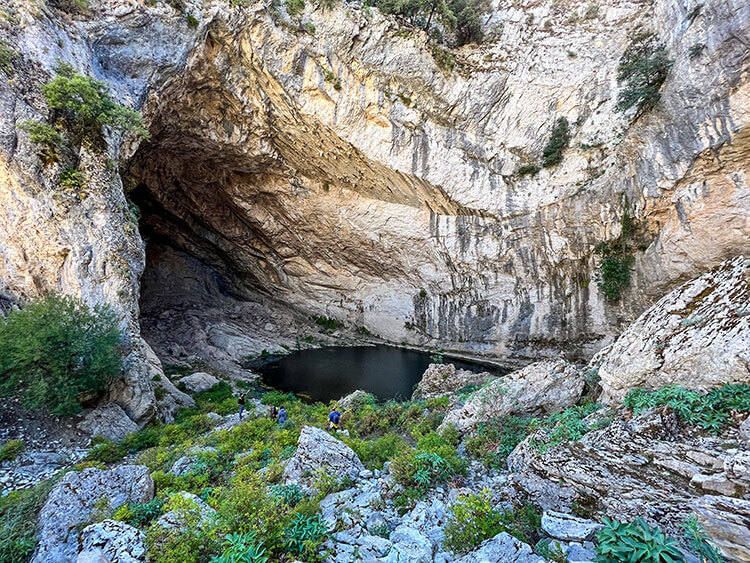
From Orgosolo, you can also visit Gorropu Canyon in the Supramonte. It’s one of the deepest canyons in Europe, and the base camp Chìntula offers a number of ways to explore it for nearly any fitness level. For us, a 4×4 tour down in to the canyon and a hike to one of the canyon’s scenic pools was the perfect way to explore Gorropu in half a day. And the guided tour is even dog friendly.
Our hike weaved through holm oak woods, past ancient nuraghi and typical shepherds houses that have been preserved, and on to a boulder strew trail as we descended down to one of the scenic pools at the bottom of the soaring 500 meter high canyon. We didn’t spot any of the golden eagles that are known to soar over the canyon, but we saw plenty of the semi-wild pigs.
Stay: Canduleri
Canduleri is a beautiful and stylish guest house in the center of Orgosolo. There’s a number of shared guest spaces like a reading nook and a terrace offering beautiful views over the village. Rooms are spacious, and the breakfast spread is more than satisfying to get started for a day of exploring.
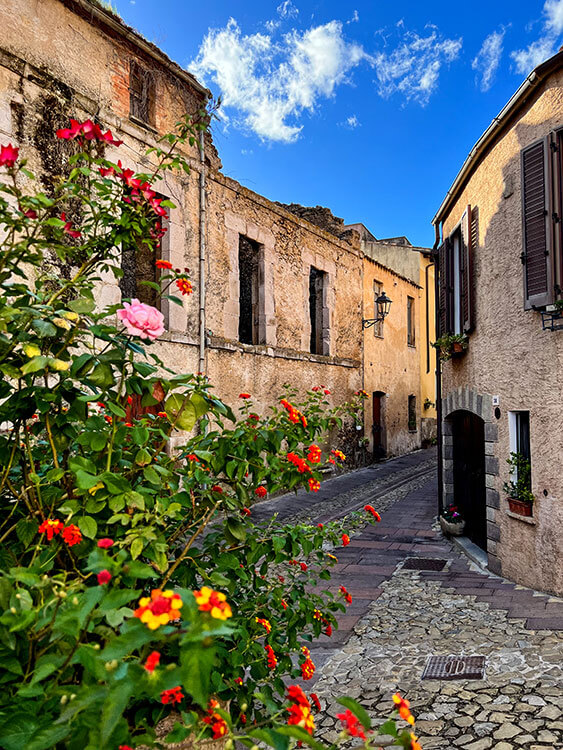
Laconi
Laconi is an underrated gem of a village tucked into central Sardinia’s heart. Famous as the birthplace of Sardinia’s most revered saint – Saint Ignatius – the village is worth the inland detour.
The village itself is small, but packed with charm. Considered a botanist’s paradise, I think every local pledged to plant a garden. And those gardens take form in creative planters on window sills, on the exterior stone walls and balconies. You can spend hours alone just wandering the cobbled streets and taking in all the charming details.
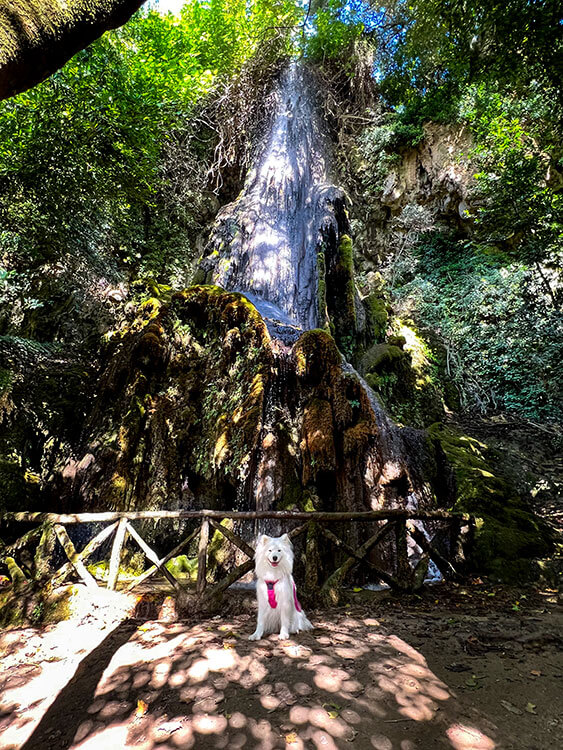
On the edge of the village sits the gem of Laconi: Parco Aymerich. It’s Sardinia’s largest urban park, and its 22 hectares includes hiking trails, waterfalls, a pond, a ruined castle and many exotic plants including unique orchids, rainbow eucalyptus, and a Lebanon cedar.
Laconi also offers the perfect growing conditions for black truffles, and has become Sardinia’s most famous truffle growing area. Truffle season is from December to June, and Laconi celebrates every June with a festival dedicated to all things truffle. You don’t have to wait until June to visit though – head to the restaurant Sa Spillunca, which is famous among locals for their truffle menu. You can even visit L’Isola dei Sapori for a truffle tasting and to buy truffle products straight from the producer.
Stay: Dè Ajala B&B
Accommodation options are quite limited in Laconi, but there are a few places to stay. Dè Ajala B&B offers both a handful of rooms in their B&B, as well as a vacation home right in the center of historic Laconi. We stayed in the vacation home, which is just a few minutes walk to the Parco Aymerich and directly across from a small public garden. The museum, restaurants and shops are all walking distance.
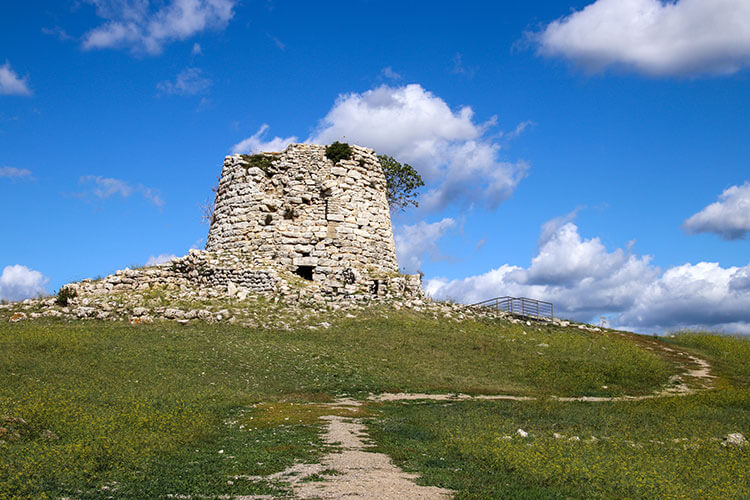
Isili
Located just a 20-minute drive from Laconi is the village of Isili. It’s famous for both the many – more than 50 to be exact – nuraghe in the area and Isili’s artificial lake. Make the drive and spend a day exploring the nuraghe and Medieval church on an island in the middle of Lago San Sebastiano.
Nuraghe are ancients structures from the Nuragic people dating back to between 1900 and 730 BC. These unique structures can be found all over Sardinia, and have become the symbol of Sardinia. Some of the most impressive are concentrated around Isili, indicating the area has been inhabited for many millennia.
Not to be missed is Nuraghe Is Paras, located right on the edge of the village of Isili. Considered to be the most elegant remaining nuragic structure in Sardinia, Nuraghe Is Paras was once upon a time the tallest dome in the world. The central tower remains largely intact, standing at 12 meters in height.
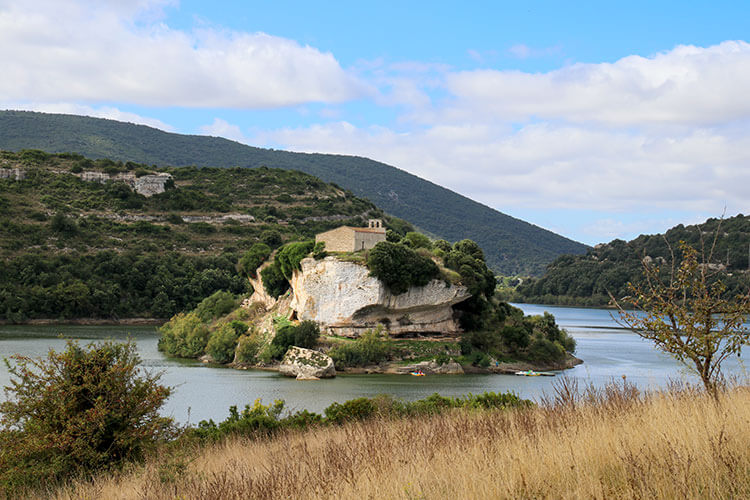
Also not to be missed is exploring Isili’s Lago San Sebastiano. It’s an artificial lake that was created by the construction of the dam Is Barrocus on the Mannu River, leaving behind a Medieval church atop a high rocky island right in the middle of the lake.
It’s a popular spot for locals to come and kayak, practice dragon boat rowing or even rent pedalos. We opted for renting a pedalo, which you can pedal over to the island. A short, but steep climb up leads you to the church dating from the 1500s.
It hasn’t been used as a place of worship in more than 200 years, though. There’s a local legend that tells the tale of a suitor disrupting a wedding at the church on the clifftop. The wedding couple both tragically fell to their deaths from the cliff during the fight with the suitor. Then the rejected suitor was also thrown to his own death by the angry mob of wedding guests. The church was never used again as a place of worship after the tragedy.
It’s probably nothing more than a tale, and the church was simply abandoned. But no matter what the reason the church ceased to be a place of worship, it undisputedly offers a beautiful view over the lake and surrounding landscape.
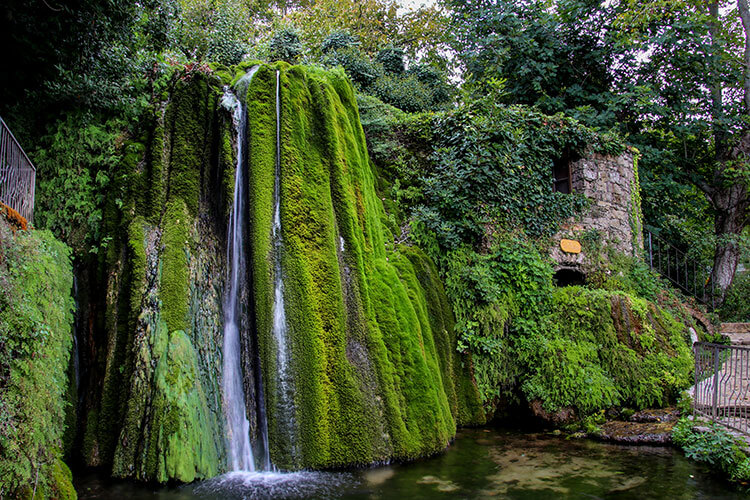
Sadali
Sadali is one of those villages that’s almost small enough that you could blink and miss it, but you certainly wouldn’t want to. One of Italy’s most beautiful villages, the village of just 1000 inhabitants is unique in Italy. A natural waterfall flows right in the heart of the village, a distinction no other place in Italy can claim.
The village was built up around this waterfall. As the legend says, a traveler carrying a statue of Saint Valentine was so transfixed by the waterfall when passing through that he stopped to watch the water flow for awhile. When we went to leave, he couldn’t budge the statue. It seemed Saint Valentine had chosen this spot, and a church was built nearby.
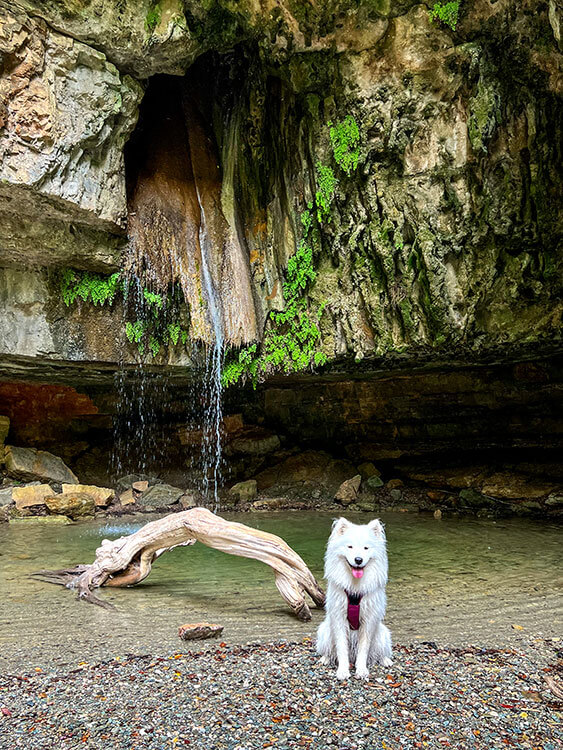
The waterfall is just one in the Sadali area. It’s part of a large network of underground water sources flowing in the surrounding mountains. Hidden nearby in the heart of the Barbagia di Seulo, and through the thick Addolì forest where there are tales of fairies living, there’s another magical waterfall. Su Stampu de Su Turrunu is at the bottom of a canyon, and it’s unique because the river disappearing into a hole in the ground up on the plateau caused the karst to fall away. Now this waterfall quite literally pours out of a hole in the cliff.
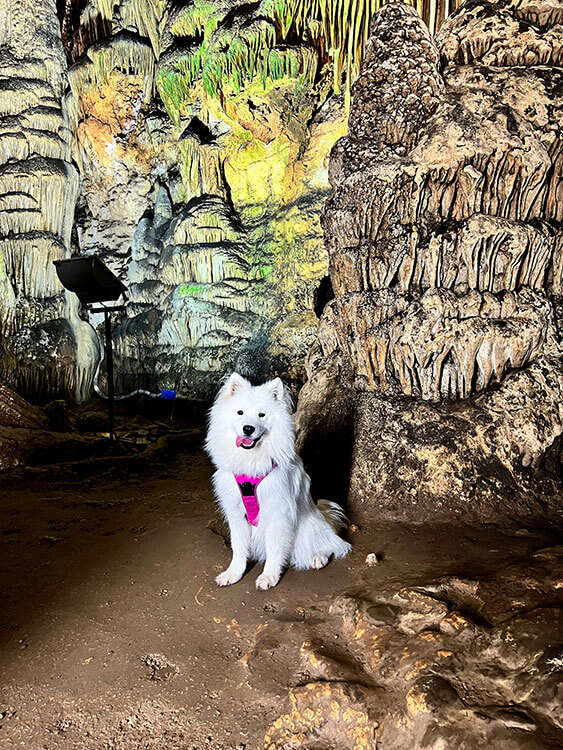
While hiking to see Su Stampu de Su Turrunu, you won’t want to miss the Grotta Is Janas. The six-room cave system is a gem of the Sadali area, and you can visit on a guided tour of the rooms so far discovered in the cave system.

Tratalias
When it comes to Italy, you might not think of abandoned ghost towns – but Italy has quite a few of them. Tratalias, located just a short distance from Sant’Antioco in Sardinia’s south west, is among the best preserved ghost towns and worth a visit.
Unlike Craco, one of Italy’s most famous ghost towns in Basilicata that I’ve visited, Tratalias wasn’t abandoned after a landslide that left it in ruins. In fact, Tratalias’s residents faced a nearly 20 year battle to save their homes before finally giving up and rebuilding a new village nearby.
The Monte Pranu dam was built in 1954, which created the artificial Lago Monte Pranu. The dam, redirection of the water of the Rio Palmas and the artificial lake caused the dangerous the resurgence of aquafiers. Ultimately, it led to the degradation of the buildings and many hygienic problems in Tratalias. In 1971, the residents were finally forced to pick up and rebuild their lives elsewhere.

The town was actually once one of the main towns of the Sulcis and even served for several hundred years as the seat of the bishop, before the diocese was transferred to Iglesias in 1503. As the seat of the bishop, Tratalias has an impressive cathedral. It’s considered to be the most beautiful and intact Romanesque monument in Sardinia, and certainly a highlight of Tratalias.
Aside from the former cathedral, a number of buildings and homes have been restored to turn Tratalias in to an open-air museum of sorts. Even a few shops, a museum, a B&B and a restaurant have taken up residence in the abandoned town. None of these were open during our visit on a Sunday afternoon, but it just lent to the eeriness of being the only soul around.
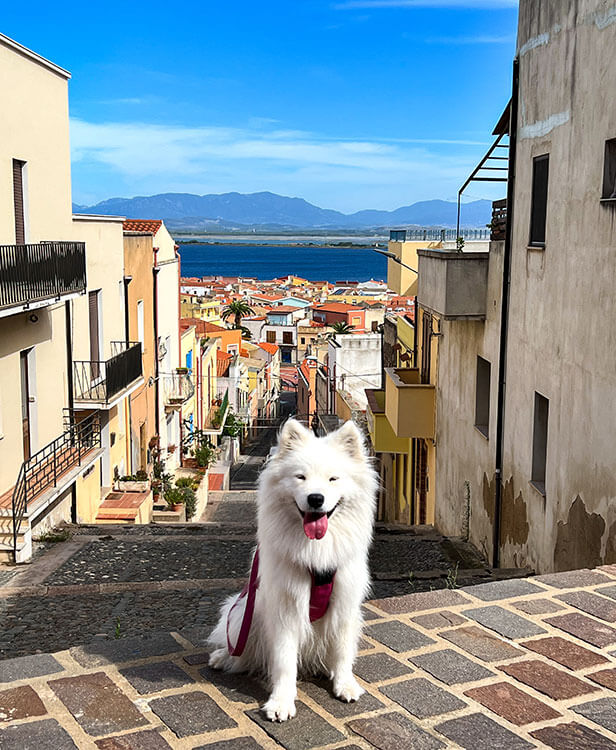
Sant’Antioco
Sant’Antioco is actually an island off the south-west tip of Sardinia, and connected to the “mainland” by an artificial isthmus thought to have built by the Romans. It takes a mere 20 minutes to cross the island by car, and around one hour to drive entirely around it. But despite its small size, Sant’Antioco offers almost an endless choice of things to do.
Arriving in Sant’Antioco practically the first sight is its seaside promenade – no doubt bustling in the summer season when the island’s population swells in size – is a lovely spot for a stroll. In the morning, you’ll find fisherman selling their day’s catch straight from their tiny boats.
Climbing up the uphill streets toward Sant’Antioco’s cathedral, you come to not only the oldest settlement in Sardinia, but in all of Italy. It’s Sulky, founded by the Phoenicians in 770 BC, now mostly left in ruins. A top this hill overlooking the colorful houses of Sant’Antioco tumbling down toward the sea, you’ll also find pre-Nuragic and Nuragic remains and a Roman catacomb complex. It’s all worth spending several hours exploring.
On the other end of town, head to the wine cooperative Cantina Sardus Pater. Established in 1949, the wine cooperative produces wines mainly from the Carignano del Sulcis grape variety grown right here on Sant’Antioco.
The vineyards of Sant’Antioco are some of the few remaining un-grafted vineyards left in Europe. Carignano del Sulcis is thought to have been cultivated in Sant’Antioco as far back as when the Phoenicians inhabited the island. The sandy soils of Sant’Antioco provide both the perfect conditions for grapes to thrive, as well as a natural protection against the devastating phylloxera that nearly wiped out winemaking in Europe.
We toured the cooperative with the local guide Bagamunda, and were lucky to see it in full action on a harvest morning before having a tasting.

Our tasting began with AD49, Cantina Sardus Pater’s sparkling vermentino produced in the Champagne method. A trio of Cantina Sardus Pater’s best Carignano del Sulcis wines followed, along with locally produced cheese and salumi.
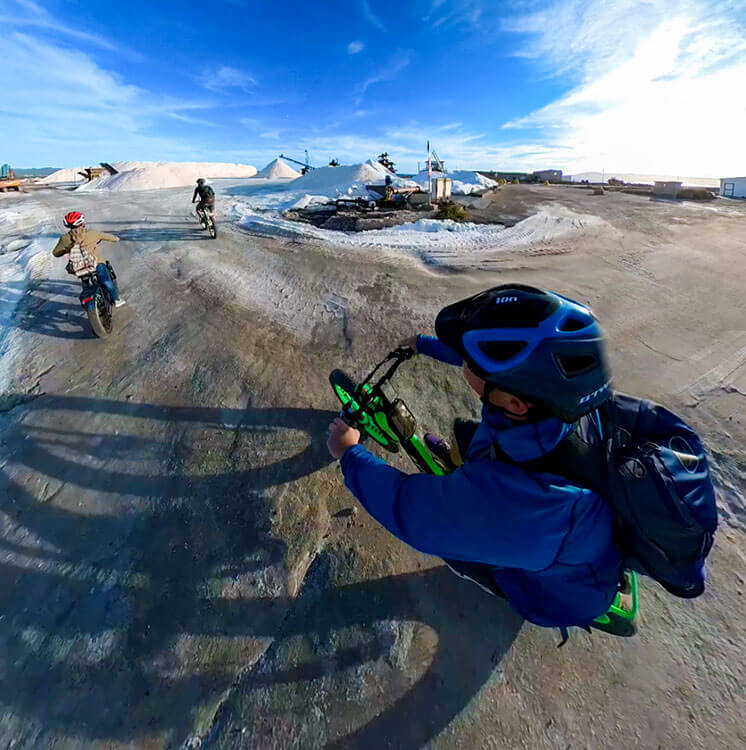
Wine isn’t Sant’Antioco’s only locally produced product. Salt has also been mined in the salt marshes just across the isthmus. And another thing not to miss is a sunset fat e-bike tour of the Salt Works.
After riding through the marshes were pink flamingos munch on the small shrimp that thrive in these super salty waters, we arrived in another world. With Sant’Antioco’s famous mistral (wind) whipping and the sea of white salt, it almost feels like this should be the Arctic. But the warm evening is a reminder that you’re just in the otherworldly salt marshes.
As the sun begins to set, that sea of white turns to a canvas of pinks, golds and blue reflected from the sea and sunset. It’s truly a sight that has to been seen.
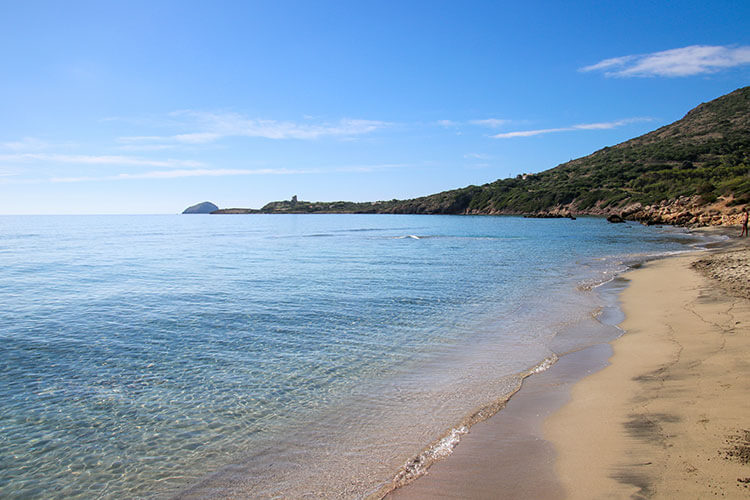
Of course, with Sant’Antioco home to some of Sardinia’s most beautiful beaches, you’ll want to spend some time exploring them. The long expanse of powdery white sand at the Spiaggia Coaquaddus is majestic, and the shallow turquoise waters are perfect for a calm swim. For sunset, head to local loved golden sand cove of Cala Sapone.
Stay: Domo La Vela
The B&B Domo La Vela is located steps away from Sant’Antioco’s seaside promenade. It is conveniently located to walking everywhere in the town of Sant’Antioco and to many restaurants. The rooms and comfortable, have air conditioning and a small fridge. There’s also a shared guest kitchen with a Nespresso. Breakfast is offered at a nearby cafe.
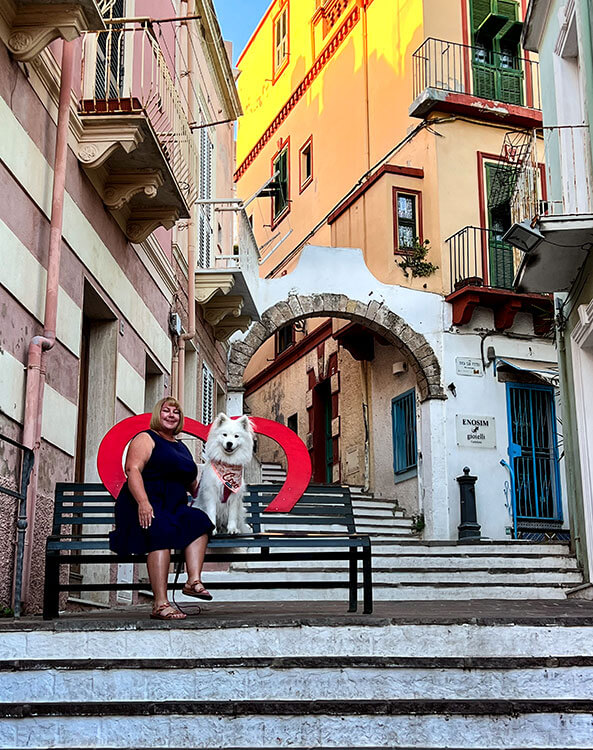
Carloforte
Even further west, but just a 30-minute ferry ride from Calasetta on Sant’Antioco lies Isola San Pietro. There’s just one town on the island and it’s the charming Carloforte, which looks and feels more like the towns of Cinque Terre than those of Sardinia. And there’s a reason for that – Isola San Pietro was settled in 1738 by Genoese fisherman who had colonized the Tunisian island of Tabarka. With the Ligurian dialect still spoken even today and Ligurian traditions still strong, it’s like a little slice of Italy’s Liguria exists just off the coast of Sardinia.
Carloforte is a maze of narrow, picturesque alleys. Steep staircases lead from one street to the next seemingly stacked on top. The town is truly a photographer’s dream.
In fact, the staircase leading up to the arch on Via Solferino is Carloforte’s most visited spot. The mysterious arch has inspired painters, photographers, poets and singers. Locals know neither when or why it was built, but the arch is thought to have been the entrance to the garden of the private home of one of Carloforte’s richest families.
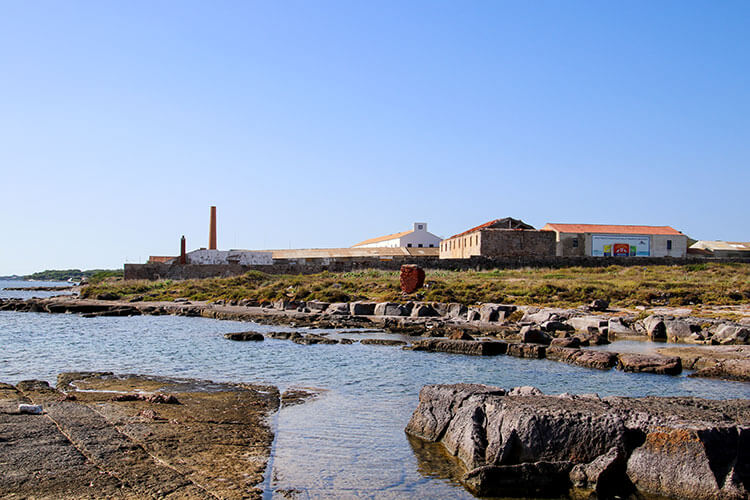
Carloforte was founded as a fishing town, and just a short distance from Carloforte is the point where bluefin tuna (known as Carloforte red tuna) enter the Mediterranean from the Atlantic. Tuna has been fished here in a traditional watch since Carloforte’s founding, and still is to this day. It’s processed locally at the Tonnara tuna processing plant, which is one of the oldest in the Mediterranean.
While we didn’t have the chance to tour the plant, where you can have a tasting of kilometer zero Carloforte tinned tuna, we did make sure to taste the famous red tuna. One of the best places for tuna is Al Tonno di Corsa in Carloforte. The restaurant offers a tuna tasting menu, with about a dozen different tuna recipes presented in the multi-course menu.

While the menu changes to present other seasonal ingredients, the concept is the same year round. You’ll start with tuna seven different ways like smoked tuna topped with a tomato relish or a cured tuna with seasonal figs. Next, a course with gnocchi with tuna ragu and the only non-tuna dish part of the tasting menu – a type of soup made from beans. I’m normally not a fan of fish in pasta, but the tuna ragu is seriously to die for. The piece de resistance is a tuna filet.
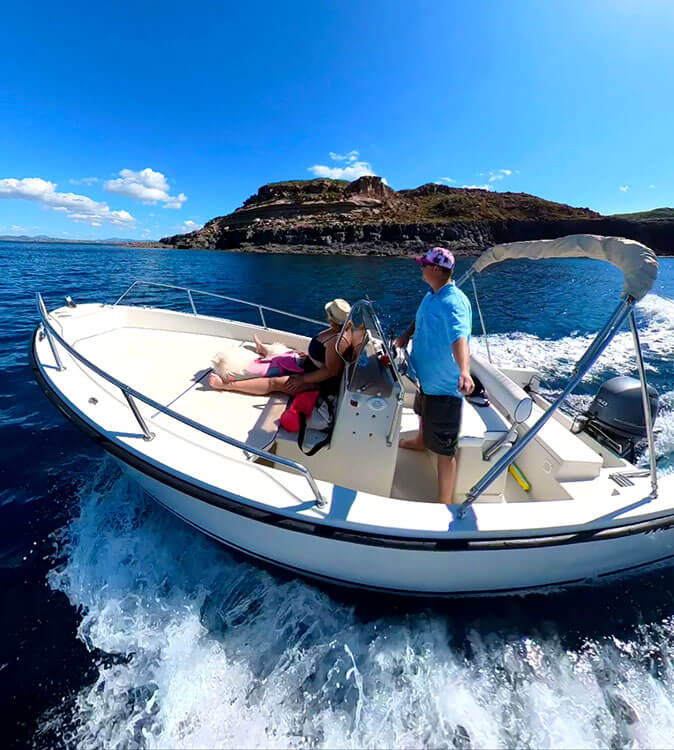
The sea plays a large role in the daily life of Carloforte. And Isola San Pietro’s coastline simply must be seen. With much of the rocky, jagged coastline inaccessible by car, the best way to see the island is by boat. And even those without a boating license can rent small boats suitable for circumnavigating the island from Marine Sifredi, which is exactly what we did.
You’ll get a lesson on sailing the boat and some tips for the best coves to anchor in. There’s rules for the distance you must keep from the coast, but you can anchor off-shore for a swim and to enjoy a picnic lunch.
Stay: Nichotel
Nichotel is just a few meters from the harbor and right in the heart of Carloforte. From our balcony, we had both a lovely view of the waterfront and of the town. Breakfast is excellent, rooms are clean and spacious and the hotel even provides a little doggy amenity kit if you’re staying with your dog. The hotel also has a restaurant (though we didn’t get to try it during our stay) and the staff are very hospitable.
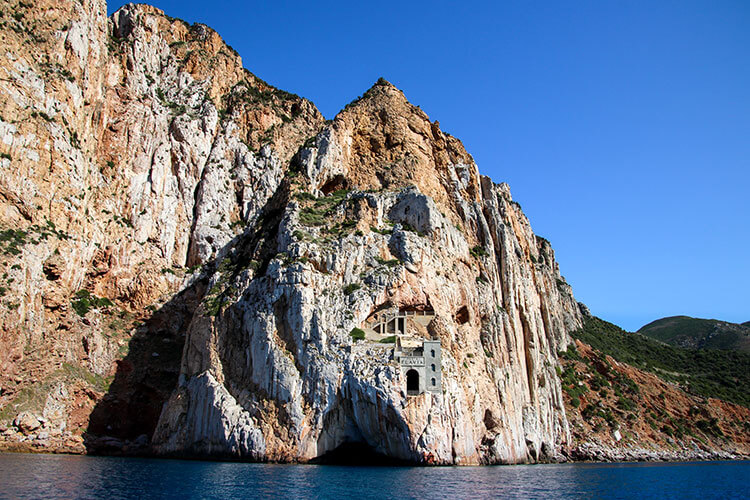
Buggerru
Mining was once the industry that drove the economy of Sardinia’s south west. The village of Buggerru is both a getaway to some of the dreamiest beaches of the island and a gateway to the treasures the mining industry left behind.
Built up around the mining industry, the village of Buggerru has a fraction of the population it had in its heyday. But these days, tourism is the main industry and Buggerru is an excellent jumping off point to tour the former mines, spend a day in the crystal clear waters of the postcard perfect Cala Domestica, and take a boat tour of the coast’s breathtaking caves and inlets.
The first order of business in Buggerru simply must be a tour of the coast with Mormora Tours. The trip along the coast glides in and out of many of the caves like the magnificent Blue Grotto and Grotta delle Spigole, before circling the impressive Pan di Zucchero and finally approaching the mining masterpiece of the Porto Flavia. It’s built directly into the cliff, and is considered a masterpiece of mining engineering.
After a morning tour of the coast, spend the afternoon soaking up the sun and taking a dip at Cala Domestica. The cove tucked between two cliffs is overlooked by an 18th century Spanish tower. The protected bay almost always has no waves, and incredibly crystal clear water. A short scramble along the rock strewn path along the right side of Cala Domestica also leads through a tiny tunnel dug out by miners, revealing a second hidden beach known as La Caletta. It’s truly one of the most picturesque beaches of south west Sardinia and can’t be missed.
Stay: Hotel ‘904
Right in the heart of Buggerru, Hotel ‘904 is conveniently located among the shops and restaurants of the village. The sandy stretch of public beach in Buggerru is a short 10 minute walk. The picturesque Cala Domestica is a 15 minute drive.
The rooms are comfortable, breakfast is cooked-to-order, and the staff is friendly and accommodating.
Our trip to Sardinia was in partnership with iAmbassador for the ‘Viaggio Italiano’ Project (Italian National Tourist Board, Ministry of Tourism & Conference of Regions and Autonomous Provinces). However, Luxe Adventure Traveler maintains full editorial control of the content published on this site. As always, all thoughts, opinions, and enthusiasm for travel are entirely our own. This article contains affiliate links. When you book on Booking.com or Viator through our affiliate partner sites, we earn a small commission at no additional cost to you.
